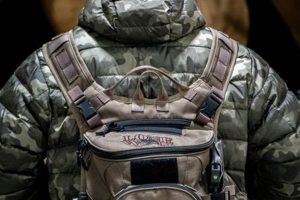The act of strategically arranging items within a rucksack for efficient carriage is a fundamental skill for various activities, from hiking expeditions to daily commutes. This process involves careful consideration of weight distribution, accessibility, and item protection. Improper execution can lead to discomfort, imbalance, and potential damage to belongings.
Optimizing the contents and organization within a pack yields numerous advantages. Proper weight distribution minimizes strain and fatigue, allowing for extended periods of comfortable carrying. Efficient arrangement ensures essential items are readily accessible when needed, saving time and frustration. Furthermore, thoughtful packing provides protection for fragile items, preventing breakage and damage during transit. Historically, organized methods of carrying have been essential for survival, enabling mobility for trade, exploration, and resource gathering.
The subsequent sections will detail the optimal methods for achieving efficient and effective load carriage. This includes guidance on item selection, weight management, compartment utilization, and techniques for securing and stabilizing the contents within a bag. Understanding these principles is crucial for anyone who regularly transports possessions on their back.
Backpack Packing Optimization
The following guidelines offer practical strategies for maximizing efficiency and comfort when preparing a rucksack for transport. Implementation of these techniques contributes to a more balanced load, improved accessibility, and reduced physical strain.
Tip 1: Weight Concentration. Place the heaviest items closest to the wearer’s back and centered within the pack. This positioning minimizes the lever effect of weight pulling away from the body, promoting stability and reducing strain on the back and shoulders. Example: A full water reservoir or dense textbooks should be situated centrally and adjacent to the back panel.
Tip 2: Compartmental Organization. Utilize designated compartments for specific categories of items. Larger compartments are suitable for bulky items such as clothing or sleeping bags. Smaller pockets are ideal for organizing accessories like toiletries, electronics, or first-aid supplies. Example: Separate clothing from food items to prevent contamination and maintain hygiene.
Tip 3: Compression Straps. Employ external compression straps to minimize bulk and stabilize the load. Tightening these straps reduces empty space within the pack, preventing items from shifting during movement. Example: Secure a rolled-up sleeping pad tightly against the bottom of the pack to prevent it from swaying.
Tip 4: Accessibility Prioritization. Position frequently needed items within easy reach. This includes essentials such as water bottles, maps, snacks, and rain gear. Utilizing external pockets or top compartments for these items eliminates the need to unpack the entire bag to access them. Example: Store a rain jacket in an accessible top pocket for quick deployment in inclement weather.
Tip 5: Item Protection. Safeguard fragile items by padding them with soft materials or placing them in protective cases. Clothing, towels, or dedicated padded inserts can prevent damage to electronics, cameras, or other sensitive equipment. Example: Wrap a camera lens in a soft cloth before placing it within the pack.
Tip 6: Load Balancing. Ensure weight is distributed evenly on both sides of the pack. Uneven weight distribution can lead to imbalances and strain on one side of the body. Utilize a scale to verify that the weight on each side is comparable. Example: If carrying two water bottles, place one on each side of the pack to maintain equilibrium.
Effective adherence to these principles contributes to a more comfortable and efficient load-carrying experience, minimizing physical strain and maximizing accessibility to essential equipment. Proper organization facilitates quicker access to necessary items, enhancing overall efficiency.
The subsequent section will address specific scenarios and further refine the presented methodologies for optimal application.
1. Weight Distribution
Effective weight distribution is a cornerstone of efficient rucksack packing. It significantly impacts comfort, stability, and overall load management. Improper weight distribution can lead to discomfort, fatigue, and potential injury. Therefore, understanding its principles is crucial for anyone who carries a pack.
- Proximity to Center of Gravity
Placing heavier items close to the wearer’s back and centered aligns the load with the body’s center of gravity. This reduces the torque on the spine and minimizes strain on supporting muscles. For example, securing dense objects like books or water reservoirs against the back panel promotes a more stable and balanced load.
- Vertical Placement
Optimally, heavier items should be positioned between the shoulder blades and the small of the back. This placement utilizes the body’s natural strength and minimizes strain on the upper back and shoulders. Packing heavier items too high can cause instability, while packing them too low can strain the lower back.
- Side-to-Side Balance
Maintaining an equal weight distribution on both sides of the pack is essential for balance and stability. Uneven distribution can lead to leaning and increased effort to maintain equilibrium. This requires careful consideration of the weight of individual items and strategic placement to counteract imbalances. For instance, if one side contains a heavier item, a counterweight should be placed on the opposite side.
- Stabilization and Compression
Utilizing compression straps and internal organization to secure the load prevents shifting and maintains weight distribution. Unsecured items can move during activity, disrupting balance and increasing strain. Compression straps minimize empty space and keep items tightly packed, contributing to a more stable and manageable load.
The principles of weight distribution are paramount in the overall process of efficient rucksack packing. By understanding and applying these facets, users can significantly improve comfort, stability, and load management, resulting in a more enjoyable and less strenuous carrying experience.
2. Compartmentalization
Compartmentalization, in the context of preparing a rucksack, refers to the strategic allocation of space within the pack using dedicated sections for specific categories of items. This organizational approach promotes accessibility, protection, and efficient utilization of available volume.
- Dedicated Sections for Item Categories
Employing distinct compartments for clothing, food, electronics, and emergency supplies promotes organization and prevents cross-contamination. For example, a separate waterproof compartment safeguards electronics from moisture, while a dedicated food compartment prevents contamination of clothing with crumbs or odors. This facilitates rapid retrieval and minimizes the risk of damage.
- Accessibility Hierarchy
Organizing items based on frequency of use enhances efficiency during travel. Commonly needed items, such as water bottles, maps, or first-aid kits, should be placed in easily accessible external pockets or top compartments. Less frequently used items can be stored in the main compartment or lower sections of the pack. This strategic arrangement minimizes the need to unpack the entire rucksack to access essential supplies.
- Protection and Security
Compartmentalization allows for the segregation of fragile or sensitive items to prevent damage during transport. Padded compartments or protective sleeves can safeguard electronics, cameras, or other delicate equipment. Separating liquids from other items minimizes the risk of spills and potential damage to surrounding contents. This proactive approach protects valuable possessions and ensures their integrity throughout the journey.
- Volume Optimization
Strategic use of compartments maximizes available space within the rucksack. Smaller pockets and dividers prevent items from shifting and settling, reducing wasted space. Compression straps within compartments further minimize bulk and stabilize the load. This efficient allocation of space allows for the carriage of a greater volume of essential equipment without compromising comfort or balance.
The effective implementation of compartmentalization within rucksack preparation significantly enhances organization, accessibility, and protection of contents. By thoughtfully assigning specific compartments to item categories and prioritizing accessibility, individuals can optimize the utilization of available space and minimize the potential for damage or inconvenience during travel.
3. Item Security
Item security, an integral aspect of effective rucksack packing, directly influences the preservation and integrity of carried belongings. Improper packing techniques can compromise item security, leading to damage, loss, or functional impairment. The connection between these two elements represents a cause-and-effect relationship: packing methodologies dictate the level of protection afforded to transported goods. For example, failing to adequately pad fragile electronic devices or inadequately sealing food containers can result in damage or contamination, respectively.
The importance of item security is underscored by the potential consequences of negligence. Damage to essential equipment, such as communication devices or navigational tools, can hinder progress or compromise safety in remote environments. Likewise, loss of critical supplies, like medication or sustenance, can create significant hardship. Proper packing mitigates these risks through techniques like utilizing protective cases, employing waterproof bags, and securing items to prevent movement within the pack. Consider a scenario where a hiker carelessly packs a camera without padding. The resulting damage from jostling during the hike renders the camera unusable, eliminating the ability to document the journey and potentially affecting safety if the camera is also used for navigation. The act of securing is also a safety matter such as sharp objects like knife or multi-tools inside the bag. If it is not place in a proper container, such as kydex or leather, there might a chance that other belongings in the bag is damaged or even worst, a physical harm to the owner.
Understanding the interplay between packing and item security is of practical significance for all individuals who transport goods in a rucksack. The implementation of appropriate packing strategies, tailored to the specific items being carried and the environmental conditions encountered, ensures the longevity and usability of essential equipment. Prioritizing item security not only protects belongings from damage but also contributes to a more efficient and stress-free travel experience. A challenge is adapting packing methods to diverse item types and travel conditions. Despite these challenges, the understanding and consistent application of these principles remain fundamental to responsible and effective load carriage.
4. Accessibility Priority
Accessibility priority, in the context of rucksack packing, refers to the strategic arrangement of contents to ensure rapid and convenient access to essential items. This aspect is crucial for maximizing efficiency and minimizing delays during transit or activity. Neglecting accessibility considerations can lead to significant inconvenience, particularly in time-sensitive or emergency situations.
- Frequency of Use
Items needed frequently, such as water bottles, snacks, navigational tools, or first-aid supplies, should be positioned for immediate retrieval. External pockets, top compartments, or designated side pouches provide easy access without requiring extensive unpacking. For example, storing a hydration reservoir in an external sleeve allows for refilling without disrupting the main pack contents.
- Environmental Factors
Anticipating potential environmental conditions necessitates prioritizing access to weather-related gear. Rain jackets, waterproof covers, or extra layers should be readily available to adapt to changing weather conditions. Placing these items in accessible outer compartments ensures swift deployment without exposing the entire pack contents to moisture.
- Emergency Preparedness
Emergency supplies, including first-aid kits, signaling devices, and navigation tools, demand immediate accessibility in critical situations. Designating a specific, easily identifiable compartment for these items allows for rapid response in emergencies. A clearly labeled first-aid kit stored in an external pocket ensures quick access to essential medical supplies.
- Task-Specific Needs
The accessibility requirements vary depending on the specific activity or task being undertaken. Photographers may prioritize access to camera equipment, while climbers require immediate access to ropes, harnesses, and other safety gear. Tailoring the packing arrangement to the task at hand optimizes efficiency and enhances performance. A photographer might utilize side-access pockets for camera lenses and batteries, allowing for quick lens changes in the field.
Integrating accessibility priority into the packing process streamlines operations and enhances overall efficiency. By strategically arranging contents based on frequency of use, environmental considerations, emergency preparedness, and task-specific needs, individuals can optimize the utility of their rucksack and minimize potential delays or inconveniences. Prioritization of accessibility constitutes a fundamental element of effective load carriage, contributing to a more seamless and productive travel experience.
5. Space Optimization
Space optimization is a critical component of effective rucksack packing, directly impacting the volume of items that can be carried and the overall efficiency of the load. Employing techniques to maximize available space minimizes bulk and weight, contributing to a more comfortable and manageable carrying experience. Failure to optimize space can result in an unnecessarily large and cumbersome pack, increasing physical strain and reducing mobility.
- Compression Techniques
Compression involves reducing the volume of compressible items, such as clothing or sleeping bags, through the use of compression sacks or straps. These techniques expel excess air, minimizing bulk and creating additional space within the pack. For instance, rolling clothing tightly and securing it with elastic bands significantly reduces its volume compared to simply folding it. This allows for the accommodation of more items within the same space, optimizing overall carrying capacity.
- Efficient Item Selection
Prioritizing essential items and eliminating unnecessary redundancies is a key aspect of space optimization. Selecting lightweight and multi-functional items minimizes weight and bulk. For example, choosing a single garment that can serve as both a mid-layer and an outer layer reduces the need for multiple separate items. This streamlined approach minimizes the overall volume and weight of the pack, enhancing mobility and reducing strain.
- Strategic Arrangement
The strategic placement of items within the rucksack can significantly impact space utilization. Filling gaps and utilizing empty spaces maximizes available volume. For instance, stuffing socks or small items into shoes or boots utilizes otherwise unused space. Careful arrangement ensures a compact and stable load, preventing items from shifting and creating wasted space.
- Modular Packing Systems
Employing modular packing systems, such as packing cubes or stuff sacks, facilitates organization and space optimization. These systems allow for the grouping of similar items, preventing them from intermixing and wasting space. Packing cubes also compress contents, reducing bulk and maximizing carrying capacity. The use of differently sized cubes allows for customized organization and efficient use of available space.
In conclusion, the successful implementation of space optimization techniques is paramount in the effective preparation of a rucksack. By employing compression methods, prioritizing essential items, arranging contents strategically, and utilizing modular packing systems, individuals can maximize carrying capacity, minimize bulk and weight, and enhance overall comfort and efficiency. The mastery of space optimization is, therefore, a fundamental element of skilled rucksack packing, contributing to a more streamlined and enjoyable travel experience.
Frequently Asked Questions
The following section addresses common inquiries and clarifies misconceptions regarding the efficient and effective preparation of rucksacks for various activities.
Question 1: Is there an optimal weight limit for a packed rucksack?
The maximum permissible weight varies depending on individual fitness, body weight, and the nature of the activity. As a general guideline, the total weight should not exceed 20-25% of the carrier’s body weight. Exceeding this limit can lead to increased strain, discomfort, and potential injury.
Question 2: How does one prevent shoulder and back pain when carrying a loaded rucksack?
Effective weight distribution, proper torso length adjustment, and appropriate use of hip belts are crucial for minimizing strain. Placing heavier items close to the back and utilizing the hip belt to transfer weight to the lower body reduces stress on the shoulders and upper back. Strengthening core muscles also contributes to improved posture and stability.
Question 3: What is the most efficient method for packing clothing to minimize space?
Rolling clothing tightly, rather than folding it, is a highly effective technique for compressing garments and maximizing space. Utilizing compression sacks or elastic bands further reduces bulk. Choosing lightweight and quick-drying fabrics also contributes to reduced volume and weight.
Question 4: How should fragile items be protected within a rucksack?
Fragile items should be surrounded by padding, such as clothing, towels, or dedicated padded inserts. Securely encasing electronics or sensitive equipment in protective cases minimizes the risk of damage from impact or compression. Distributing these items within the pack, rather than concentrating them in one area, further reduces the potential for harm.
Question 5: What is the recommended method for organizing items within a rucksack to facilitate accessibility?
Frequently used items, such as water bottles, snacks, or rain gear, should be placed in easily accessible external pockets or top compartments. Less frequently needed items can be stored in the main compartment or lower sections of the pack. Utilizing internal dividers or packing cubes promotes organization and prevents items from shifting during transit.
Question 6: How does one secure a rucksack to prevent items from shifting during activity?
Utilizing internal and external compression straps effectively stabilizes the load and minimizes movement. Tightening these straps reduces empty space within the pack, preventing items from shifting during movement. Packing heavier items towards the bottom of the pack and securing them with straps further enhances stability.
Adherence to these guidelines contributes to a more comfortable and efficient load-carrying experience, minimizing physical strain and maximizing accessibility to essential equipment. Consistent application of these techniques ensures the longevity and usability of carried belongings.
The subsequent section will offer specific examples and case studies illustrating the application of these principles in various scenarios.
The Enduring Importance of Backpacking Proficiency
This exposition has illuminated the critical elements of the process of “how to pack a backpack,” encompassing weight distribution, compartmentalization, item security, accessibility prioritization, and space optimization. Effective implementation of these strategies directly influences comfort, load management, and the preservation of carried belongings. A comprehensive understanding and meticulous application of these principles are fundamental for anyone who regularly transports possessions within a rucksack.
The knowledge and skills imparted herein provide a foundation for enhanced efficiency and preparedness in various endeavors. The principles outlined represent not merely a set of techniques, but a pathway toward responsible and effective load carriage. Continuous refinement of these skills is encouraged, leading to improved experiences and enhanced capabilities in all activities requiring rucksack utilization. The journey toward optimized carrying capacity and physical well-being should now drive those who seek to master these techniques.





![Best Reflective Motorcycle Backpack for Safe Rides [Guide] Ultimate Backpack Traveler Guide: Tips, Destinations & Budget Hacks Best Reflective Motorcycle Backpack for Safe Rides [Guide] | Ultimate Backpack Traveler Guide: Tips, Destinations & Budget Hacks](https://backpack-traveler.com/wp-content/uploads/2025/12/th-658-300x200.jpg)

